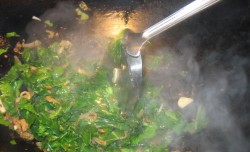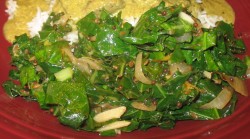Asian Ways With American Winter Greens, Part II
I have found that nearly everyone, the world over, eats greens, in one form or another.
In my native Southern Appalachian tradition, we cook them long and slow, over low heat, with some sort of smoked pork product. Often, onions, garlic and hot peppers are added, and then, at the end, they are dressed with vinegar. The vitamin (and pork fat) filled liquid, called “pot likker” by us hillbillies, turns into a rich, heady brew by the end, and is often sopped up with cornbread or biscuits. Richly smoky and intensely flavored, the greens and likker, kissed with the tartness of apple cider vinegar, are a supreme comfort food for those of us who grew up in the South, no matter our race, creed or socio-economic background.
But, one cannot live by pot likker alone, and so I have been exploring different ways to go about cooking my beloved kale, chard, turnip, mustard, collard and beet greens, and have found some really great inspirations from the kitchens of Asia.
Last week, I posted about how steamed American mustard greens with Chinese fermented black beans are a real treat; this week, I want to give you a recipe that dips into the deep traditions of Southern India, which I have mostly learned about by reading Indira’s wonderful blog, Mahanandi.
Most of my Indian recipes are strongly rooted in the cuisines of northern India, Pakistan and Bangladesh, in large part because these are the foods most often presented in American Indian restaurants. The fact that I learned a lot of recipes by cooking for a Pakistani/Bangladeshi Muslim family also played an important role in the process of my education in Indian foods. However, as I have read Indira’s beautiful descriptions and clear recipes, an interest in the cookery of Southern India has been kindled, and so, I have been reading cookbooks, memoirs and, most importantly, experimenting in the kitchen.
This recipe, which uses a mixture of American greens (my favorite combination for this is collards, kale and mustard) is not only inspired by Indira’s writings but contains an ingredient which she introduced to me: dahlia powder. She also calls it, in her language, pappula podi, or putnala podi, but in our house, Morganna, Zak and I refer to it as “Indira’s Magic Powder,” because she sent me a jar of it months ago, and I have been using it since then in vegetable curries to a splendid effect that is nothing short of alchemical.
Made simply of roasted, skinned and split chana (chickpeas), which are ground up with dried chiles, coconut, cumin and salt ground together, “Indira’s Magic Powder” thickens curries and flavors them with a surprising depth. The roasted chickpeas have a nutty aroma that complements nearly any vegetable, but which especially goes well with the slightly bitter tanginess of mixed greens, while the coconut adds richness and the chiles and cumin contribute fire and spice.
Having long since run out of the original jar, I have gone on to make my own stash of Indira’s Magic Powder, and I suggest that you do the same. Just follow the link to her recipe, collect the ingredients, grind them together and store them in an airtight container and you are good to go.
As for the rest of the ingredients for this dish–they are simple to obtain: mustard oil, whole mustard seeds, cumin seeds and fresh curry leaves can all be found at the Asian or Indian market near you, or can be sourced online, while everything else can be found at any American supermarket.
I served this dish on New Year’s Eve night, when we had an Indian feast to celebrate the holiday, and this past Sunday for Morganna’s seventeenth birthday party. Both times, it was received with great enthusiasm, and I am very proud that not only was it loved by the people of Indian descent who ate it, but also by my mother, who had never had Indian food before in her life.
Mom wanted the recipe, so here it is.
Ingredients:
4 tablespoons mustard-flavored oil (or ghee or canola oil)
1 large onion, peeled and very thinly sliced (about a cup and half)
1/2 teaspoon salt
3 large cloves garlic, peeled and thinly sliced
fresh cayenne chiles, green or red, thinly sliced on the bias (optional–use as many or few as you like)
20 fresh curry leaves (optional)
1 tablespoon whole mustard seeds
1/2 tablespoon whole cumin seeds
1 pound mixed greens, well-washed, large stems removed and cut into thin ribbon-like slices (try to use at least some mustard greens here–their spiciness makes them delicious cooked like this)
1/2 cup water
3-5 tablespoons Indira’s Magic Powder (pappula podi)
juice of one lime
salt to taste
Method:
Heat wok, or large, deep cast iron frying pan until it smokes. Add oil and when it is hot (about twenty seconds), add the onions and salt. Stir fry until the onion is golden colored. Add the garlic, the chiles and curry leaves, and keep stirring until the onions are beginning to really turn brown. Add the whole spices, and keep stirring until the onions turn reddish brown and the mustard seeds pop.
Add the greens, and pour in the water. Stir the hot onions on top of the greens, then briefly cover the wok or pan with a lid or an upside down bowl to allow the greens to steam for about a minute or two. Uncover, and if there is very little water left, add some more–a quarter cup at a time, and stir until the greens deepen in color and start to go limp.
Stir in the Magic Powder, and keep stirring until the water thickens to a nice curry paste. Add the juice of one lime and salt to taste, then serve immediately with rice and various other curries.
6 Comments
RSS feed for comments on this post.
Sorry, the comment form is closed at this time.
Powered by WordPress. Graphics by Zak Kramer.
Design update by Daniel Trout.
Entries and comments feeds.





How many people should this normally serve? (I can easily see it being ‘one’ or maybe ‘two’ but what is the intended number?)
Comment by Steve Hutchison — February 1, 2007 #
Steve, it depends on how much food you are making–in other words, this is a side dish. If you have three or four other dishes–or more, you can stretch this dish to feed four to six.
For one or two dishes–this is good for two or three folks.
If you are really hungry and eating it with just rice, this will feed one person.
Comment by Barbara — February 1, 2007 #
Hi Barbara,
The greens prepared in this way look great. This is how we prepare a curry with greens often and the standard method for many greens like spinach, fenugreek etc.
I am really glad to hear that you prepared another batch of spicy powder. The recipe is a traditional one and all the credit goes to good looking, great tasting pappulu.:)
Another use for this powder is sprinkle some on dosas. Along with potato curry, pappula podi is also added in Mysore masala dosas. Lip smacking good. And it is often used to make gravy/sauce for for vegetables like chayote and bottlegourd etc.
Happy cooking Barbara!
Comment by Indira — February 1, 2007 #
We have been rediscovering collard greens recently. First we had them western style and then tossed in pasta with garlic and then on an Indian dinner night, switched to Indian style with potatoes and ginger and mustard seeds. No big surprise – they were fabulous every time.
One really exciting new ingredient (for us, anyway) was added to the Indian version and it is all due to you, Barbara. Because of your review of it, we were reading Shoba Narayan’s “Monsoon Diary”. We saw that she often called for dry frying about 1 Tbsp urad dahl at the beginning of some of her dishes. WHAT a great addition to greens!! We love the nutty taste and the lovely slightly crunchy texture that the dahl adds to greens.
And now I’m really intrigued about pappula podi and will scurry over to Indira’s site to read more.
-Elizabeth
-Elizabeth
Comment by ejm — February 5, 2007 #
Greens!
I’ve been scanning through your archives today looking for an article, I think it was here I first read it, about a guy who tried to eat only food he produced in his own yard on summer. My memory of the article was that he was just looking of an angle and the way he conducted the experiment was terribly stupid. However, reading through the archives has been wonderful! Your love of cooking and local food shines through on every page.
I’m commenting here because kale is all I have left in my garden. Even under the snow and ice it still lives and when the weather warms for a day or two I can run out and harvest a few handfuls. Post freeze kale is so sweet and mild, cooking up softer and less leathery than summer kale.
Being in northeast Ohio, Youngstown, I wanted to see how kale would do, so I bought a mixture of Siberian kale seeds for last summer’s garden. They grew quite well, survived the summer’s drought, had very few insect problems (unlike the Swiss Chard which looked like lace all summer long) and have survived through mid December.
Happy Holidays,
John
Comment by John Thornton — December 16, 2007 #
John–we always waited with anticipation for the first frost, because the kale was always so wonderful then–the starches turn to sugars almost like magic.
As for that article–it sounds like a book I read but didn’t review, because I thought it was kind of weird–but cool, but weird.
I am glad you are enjoying the archives–there is a lot of stuff in there that is fun, and I hope that you enjoy some of the recipes, too.
Happy Holidays!
Comment by Barbara — December 17, 2007 #